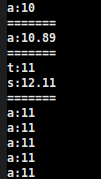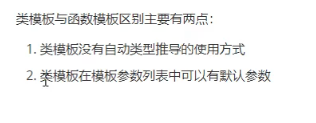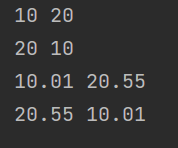一.函数模板

可看出就是将函数返回类型和形参类型去掉。
1.代码1
#include <iostream>
#include <vector>
#include <string>
#include <algorithm>
#include <map>
#include <fstream>
using namespace std;template<typename T>
void swap_(T& a, T& b ){T temp = a;a = b;b = temp;
}
int main()
{//1.自动类型推导 必须要一致的数据类型才可用int a1 = 10, b1 = 20;cout<<a1<<" "<<b1<<endl;swap_(a1, b1);cout<<a1<<" "<<b1<<endl;float a2 = 10.01, b2 = 20.55;cout<<a2<<" "<<b2<<endl;swap_(a2, b2);cout<<a2<<" "<<b2<<endl;//2.显示指定类型swap_<int>(a1, b1);cout<<a1<<" "<<b1<<endl;swap_<float>(a2, b2);cout<<a2<<" "<<b2<<endl;return 0;
}有两种使用方式,一个是自动类型推导(必须要一致的数据类型才可用),一个是显示指定类型。
2.代码2
将类型作为参数,用template修饰函数模板,解决不同类型函数但实现逻辑一样的问题

#include <iostream>
using namespace std;template <typename T>//函数模板
void display(T a)
{cout<<"a:"<<a<<endl;cout<<"======="<<endl;
}template <typename T,typename S>//函数模板
void display(T t, S s)
{ cout<<"t:"<<t<<endl;cout<<"s:"<<s<<endl;cout<<"======="<<endl;
}template <typename T,int KSize>//函数模板
void display(T a)
{for (int i=0;i<KSize;i++){cout<<"a:"<<a<<endl;}}int main()
{ display<int>(10);//模板函数display<double>(10.89);//模板函数display<int,float>(11,12.11);//模板函数display<int, 5>(11);return 0;
}
3.代码3
选择排序,降序排序
#include <iostream>
#include <vector>
#include <string>
#include <algorithm>
#include <map>
#include <fstream>
using namespace std;template<typename T>
void swap_(T& a, T& b){T temp = a;a = b;b = temp;
}//从大到小排序
template<typename T>
void sort_(T& arr){int n = sizeof(arr) / sizeof(arr[0]);for(int i = 0; i < n; i++){int index = i;for(int j = i + 1; j < n; j++){if(arr[index] < arr[j]){index = j;}}if(index != i){swap_(arr[index], arr[i]);}}
}
template <typename T>
void printArr(T& arr){int n = sizeof(arr) / sizeof(arr[0]);for(int i = 0; i < n; i++ ){cout<<arr[i]<<" ";}cout<<endl;
}
int main()
{
// test06();char charArr[] = "bdfdsskn";sort_(charArr);printArr(charArr);int intArr[] = {6, 7, 4, 6, 8, 2, 3, 7};sort_(intArr);printArr(intArr);return 0;
}4.普通函数和模板函数的调用规则

![]()
4.1如果函数模板和普通函数都可以调用,优先调用普通函数
#include <iostream>
#include <vector>
#include <string>
#include <algorithm>
#include <map>
#include <fstream>
using namespace std;//
void myPrint(int a, int b){cout<<"调用的普通函数"<<endl;
}template <typename T>
void myPrint(T a, T b){cout<<"调用的函数模板"<<endl;
}
void test06(){int a = 10, b = 20;//如果函数模板和普通函数都可以调用,优先调用普通函数myPrint(a, b);
}
int main()
{test06();return 0;
}4.2通过空模板参数列表,强制调用函数模板
#include <iostream>
#include <vector>
#include <string>
#include <algorithm>
#include <map>
#include <fstream>
using namespace std;//
void myPrint(int a, int b){cout<<"调用的普通函数"<<endl;
}template <typename T>
void myPrint(T a, T b){cout<<"调用的函数模板"<<endl;
}
void test06(){int a = 10, b = 20;// 通过空模板参数列表,强制调用函数模板myPrint<>(a, b);
}
int main()
{test06();return 0;
}4.3重载函数模板
#include <iostream>
#include <vector>
#include <string>
#include <algorithm>
#include <map>
#include <fstream>
using namespace std;//
void myPrint(int a, int b){cout<<"调用的普通函数"<<endl;
}template <typename T>
void myPrint(T a, T b){cout<<"调用的函数模板"<<endl;
}template <typename T>
void myPrint(T a, T b, T c){cout<<"调用的重载函数模板"<<endl;
}
void test06(){int a = 10, b = 20;// 通过 空模板参数列表,强制调用模板函数myPrint<>(a, b);myPrint<>(a, b, 100);
}
int main()
{test06();return 0;
}4.4 如果函数模板能够产生更好的匹配,优先使用函数模板
#include <iostream>
#include <vector>
#include <string>
#include <algorithm>
#include <map>
#include <fstream>
using namespace std;//
void myPrint(int a, int b){cout<<"调用的普通函数"<<endl;cout<<"a:"<<a<<endl;cout<<"b:"<<b<<endl;
}template <typename T>
void myPrint(T a, T b){cout<<"调用的函数模板"<<endl;cout<<"a:"<<a<<endl;cout<<"b:"<<b<<endl;
}template <typename T>
void myPrint(T a, T b, T c){cout<<"调用的重载函数模板"<<endl;cout<<"a:"<<a<<endl;cout<<"b:"<<b<<endl;cout<<"c:"<<c<<endl;
}
void test06(){int a = 10, b = 20;char c1 = 'a';char c2 = 'b';// 优先将T推导为char 类型myPrint(c1, c2);
}
int main()
{test06();return 0;
}可看出优先将T转换成char,而不是将char字符一个一个转换成int类型。
二.类模板

类模板语法和函数模板语法很接近,都是先声明模板出来。
与函数模板差异

1.代码1:
#include <iostream>
#include <vector>
#include <string>
#include <algorithm>
#include <map>
#include <fstream>
using namespace std;template <class NameType, class AgeType>
class Person{
public:Person(NameType name, AgeType age){this->m_Name = name;this->m_Age = age;}void showPerson(){cout<<"name:"<<this->m_Name<<" age:"<<this->m_Age<<endl;}NameType m_Name;AgeType m_Age;
};void test06(){Person<string, int> p1("lining", 13);p1.showPerson();
}
int main()
{test06();return 0;
}![]()



MyArray.h
#ifndef MYARRAY_H
#define MYARRAY_H
#include <iostream>
using namespace std;template <typename T, int KSize, int KVal>//T就是要定义的类型class MyArray
{public:MyArray();~MyArray(){delete []m_pArr;m_pArr=NULL;};void display();private:T *m_pArr;
};template <typename T,int KSize, int KVal>//函数定义时 一定要写
MyArray<T, KSize, KVal>::MyArray()
{m_pArr = new T[KSize];for (int i=0;i<KSize;i++){m_pArr[i] = KVal;}
}template <typename T,int KSize, int KVal>//函数定义时 一定要写
void MyArray<T, KSize, KVal>::display()
{for (int i=0;i<KSize;i++){cout<<"m_pArr[i]:"<<m_pArr[i]<<endl;}
}#endifdemo.cpp
#include <iostream>
#include <string>
#include "MyArray.h"
using namespace std;int main()
{ MyArray<int, 5, 6> arr;//每个元素都是6共5个元素的数组arr.display();return 0;
}
2.与函数模板差异
1.类模板没有自动推导方式
2.类模板中的参数列表可以有默认类型
#include <iostream>
#include <vector>
#include <string>
#include <algorithm>
#include <map>
#include <fstream>
using namespace std;
//类模板中的参数列表可以有默认类型
template <class NameType, class AgeType = int>
class Person{
public:Person(NameType name, AgeType age){this->m_Name = name;this->m_Age = age;}void showPerson(){cout<<"name:"<<this->m_Name<<" age:"<<this->m_Age<<endl;}NameType m_Name;AgeType m_Age;
};void test06(){
// Person p1("lining", 13); //错误的
// Person<string, int> p2("lining", 13);Person<string> p2("lining", 13); //有默认类型所以这里可以省去intp2.showPerson();
}
int main()
{test06();return 0;
}![]()
3.类模板中成员函数和普通类成员函数创建方式

因为不知道是啥类型, 类模板中的成员函数在调用时才创建
#include <iostream>
#include <vector>
#include <string>
#include <algorithm>
#include <map>
#include <fstream>
using namespace std;
//类模板中的成员函数在调用时才创建 (因为不知道是啥类型)
//普通类中的成员函数一开始就创建
class Person1{
public:void showPerson1(){cout<<"showPerson1()"<<endl;}
};class Person2{
public:void showPerson2(){cout<<"showPerson2()"<<endl;}
};
template<class T>
class Myclass{
public:T obj;//类模板中的成员函数void func1(){obj.showPerson1();}void func2(){obj.showPerson2();}
};
void test06(){Myclass<Person1> m;m.func1();m.func1();
}int main()
{test06();return 0;
}
4.类模板对象做函数参数

#include <iostream>
#include <vector>
#include <string>
#include <typeinfo>
#include <algorithm>
#include <map>
#include <fstream>
using namespace std;
//类模板对象做函数参数
template<class T1, class T2>
class Person{
public:Person(T1 name, T2 age){this->m_Name = name;this->m_Age = age;}void showPerson(){cout<< "姓名: " << this->m_Name <<" 年龄: "<< this->m_Age <<endl;}T1 m_Name;T2 m_Age;
};//1.指定传入类型 (最常用)
void printPerson1(Person<string, int>&p){p.showPerson();
}
//2.参数模板化
template<class T1, class T2>
void printPerson2(Person<T1, T2>&p){p.showPerson();cout<<"T1类型: "<<typeid(T1).name()<<endl;cout<<"T2类型: "<<typeid(T2).name()<<endl;
}
//3.整个类模板化
template<class T>
void printPerson3(T &p){p.showPerson();cout<<"T类型: "<<typeid(T).name()<<endl;
}
void test06(){Person<string, int>p("limin", 100);printPerson1(p);printPerson2(p);printPerson3(p);
}int main()
{test06();return 0;
}
5.类模板与继承

#include <iostream>
#include <vector>
#include <string>
#include <typeinfo>
#include <algorithm>
#include <map>
#include <fstream>
using namespace std;template<class T>
class Base{
public:T m;
};
//class Son1:public Base{ //错误的,必须要知道父类中的T类型,才能继承给子类
class Son1:public Base<int>{};
template<class T1, class T2>
class Son2:public Base<T2>{ //如果想灵活指定父类中的T类型,子类也需要变类模板
public:Son2(){cout<<" T1类型: "<<typeid(T1).name()<<endl;cout<<" T2类型: "<<typeid(T2).name()<<endl;}T1 obj;
};void test06(){Son1 s1;Son2<int, char> s2;
}int main()
{test06();return 0;
}
6.类模板成员函数类外实现
#include <iostream>
#include <vector>
#include <string>
#include <typeinfo>
#include <algorithm>
#include <map>
#include <fstream>
using namespace std;//类模板成员函数类外实现
template<class T1, class T2>
class Person{
public:Person(T1 name, T2 age);//类内实现构造函数
// Person(T1 name, T2 age){
// this->m_Name = name;
// this->m_Age = age;
// }
// void showPerson(){
// cout<<" 姓名: "<<this->m_Name<< " 年龄: " <<this->m_Age<<endl;
// }void showPerson();T1 m_Name;T2 m_Age;
};
//构造函数类外实现
template<class T1, class T2>
Person<T1, T2>::Person(T1 name, T2 age){this->m_Name = name;this->m_Age = age;
}
//成员函数类外实现
template<class T1, class T2>
void Person<T1, T2>::showPerson(){cout<<" 姓名: "<<this->m_Name<< " 年龄: " <<this->m_Age<<endl;
}
void test06(){Person<string, int>p("limin", 100);p.showPerson();
}int main()
{test06();return 0;
}![]()
7.类模板类分文件编写

7.1.第一种方式:因为类模板成员函数一开始是不会创建的,所以包含.h头文件不会创建类模板成员函数,导致链接阶段无法找到。而改为#include .cpp就可以看见.h成员函数和实现方式.
demo.cpp
#include <iostream>
#include <vector>
#include <string>
#include <typeinfo>
#include <algorithm>
#include <map>
#include <fstream>
//#include "Person.h" //错误不能调用
#include "Person.cpp" //改为.cpp文件就行
//#include "Person.hpp" //改为.hpp文件就行 里面包含函数声明与实现
using namespace std;void test06(){Person<string, int>p("limin", 100);p.showPerson();
}int main()
{test06();return 0;
}Person.h
#pragma once //防止头文件重复包含
#include <iostream>
#include <vector>
#include <string>
#include <typeinfo>
#include <algorithm>
#include <map>
#include <fstream>
using namespace std;//类模板成员函数类外实现
template<class T1, class T2>
class Person{
public:Person(T1 name, T2 age);void showPerson();T1 m_Name;T2 m_Age;
};Person.cpp
#include <iostream>
#include <vector>
#include <string>
#include <typeinfo>
#include <algorithm>
#include <map>
#include <fstream>
#include "Person.h"
using namespace std;
//构造函数类外实现
template<class T1, class T2>
Person<T1, T2>::Person(T1 name, T2 age){this->m_Name = name;this->m_Age = age;
}
//成员函数类外实现
template<class T1, class T2>
void Person<T1, T2>::showPerson(){cout<<" 姓名: "<<this->m_Name<< " 年龄: " <<this->m_Age<<endl;
}
CMakeLists.txt
cmake_minimum_required(VERSION 3.4.1)
project(Infantry)
add_definitions(-std=c++11)
set(CMAKE_BUILD_TYPE Debug)
set(SRC_LIST demo.cpp Person.cpp Person.h)
#set(SRC_LIST demo.cpp Person.hpp)
add_executable(demo ${SRC_LIST})![]()
7.2函数声明和实现都在.hpp。
Person.hpp
#pragma once //防止头文件重复包含
#include <iostream>
#include <vector>
#include <string>
#include <typeinfo>
#include <algorithm>
#include <map>
#include <fstream>
using namespace std;//类模板成员函数类外实现
template<class T1, class T2>
class Person{
public:Person(T1 name, T2 age);void showPerson();T1 m_Name;T2 m_Age;
};
//构造函数类外实现
template<class T1, class T2>
Person<T1, T2>::Person(T1 name, T2 age){this->m_Name = name;this->m_Age = age;
}
//成员函数类外实现
template<class T1, class T2>
void Person<T1, T2>::showPerson(){cout<<" 姓名: "<<this->m_Name<< " 年龄: " <<this->m_Age<<endl;
}demo.cpp
#include <iostream>
#include <vector>
#include <string>
#include <typeinfo>
#include <algorithm>
#include <map>
#include <fstream>
//#include "Person.h" //错误不能调用
//#include "Person.cpp" //改为.cpp文件就行
#include "Person.hpp" //改为.hpp文件就行 里面包含函数声明与实现
using namespace std;void test06(){Person<string, int>p("limin", 100);p.showPerson();
}int main()
{test06();return 0;
}CMakeLists.txt
cmake_minimum_required(VERSION 3.4.1)
project(Infantry)
add_definitions(-std=c++11)
set(CMAKE_BUILD_TYPE Debug)
#set(SRC_LIST demo.cpp Person.cpp Person.h)
set(SRC_LIST demo.cpp Person.hpp)
add_executable(demo ${SRC_LIST})![]()
8.类模板配合友元函数的类内和类外实现
8.1.全局函数类内实现
#include <iostream>
#include <vector>
#include <string>
#include <typeinfo>
#include <algorithm>
#include <map>
#include <fstream>
using namespace std;template<class T1, class T2>
class Person{//全局函数 类内实现friend void printPerson(Person<T1, T2> p){cout<<" 姓名: "<<p.m_Name<< " 年龄: " <<p.m_Age<<endl;}
public:Person(T1 name, T2 age){this->m_Name = name;this->m_Age = age;}
// void showPerson(){
// cout<<" 姓名: "<<this->m_Name<< " 年龄: " <<this->m_Age<<endl;
// }
private:T1 m_Name;T2 m_Age;
};
void test06(){//全局函数类内实现的测试Person<string, int>p("limin", 100);printPerson(p);
}int main()
{test06();return 0;
}![]()
8.2 全局函数类外实现
如果全局函数是类外实现的话 需要编译器提前知道这个函数的存在
9.案例

MyClass.hpp
#pragma once //防止头文件重复包含
#include <iostream>
#include <vector>
#include <string>
#include <typeinfo>
#include <algorithm>
#include <map>
#include <fstream>
using namespace std;//类模板成员函数类外实现
template<class T>
class MyArray{
public://有参构造MyArray(int capacity){cout<<"调用构造函数"<<endl;this->m_capacity = capacity;this->m_size = 0;this->pAddress = new T[this->m_capacity]; //开辟堆区空间}//拷贝构造函数MyArray(const MyArray<T>& arr){cout<<"调用拷贝构造函数"<<endl;this->m_capacity = arr.m_capacity;this->m_size = arr.m_size;this->pAddress = new T[arr.m_capacity];//深拷贝//将arr中的数据拷贝过来for(int i=0; i<this->m_size; i++){this->pAddress[i] = arr.pAddress[i];}}//尾插法void PushBack(const T& value){//先判断是否等于大小if(this->m_capacity == this->m_size){return;}this->pAddress[this->m_size] = value; //尾插法this->m_size++; //更新数组大小}//尾删法void PopBack(){//让用户访问不了最后一个元素if(this->m_size == 0){return;}this->m_size--; //更新数组大小}//通过下标方式访问数组中元素T& operator[](int index){return this->pAddress[index];}//返回数组容量int getCapacity(){return this->m_capacity;}//返回数组大小int getSize(){return this->m_size;}//operator= 也是防止浅拷贝MyArray& operator=(const MyArray<T>& arr){cout<<"调用operator= 函数"<<endl;//先判断原来堆区是否与数据,如果有先释放if(this->pAddress != NULL){delete []this->pAddress;this->pAddress = NULL;this->m_capacity = 0;this->m_size = 0;}//深拷贝this->m_capacity = arr.m_capacity;this->m_size = arr.m_size;this->pAddress = new T[arr.m_capacity];//深拷贝//将arr中的数据拷贝过来for(int i=0; i<this->m_size; i++){this->pAddress[i] = arr.pAddress[i];}return *this;}virtual ~MyArray(){cout<<"调用析构函数"<<endl;if(this->pAddress != NULL){delete []this->pAddress;this->pAddress = NULL;}}
private:int m_capacity;int m_size;T* pAddress; //指针指向堆区开辟的真实数组
};
demo.cpp
#include <iostream>
#include <vector>
#include <string>
#include <typeinfo>
#include <algorithm>
#include <map>
#include <fstream>
#include "MyClass.hpp"
using namespace std;void test06(){MyArray<int> arr1(20);MyArray<int> arr2(arr1);MyArray<int> arr3(10);arr3 = arr1;for(int i=0; i<5; i++){arr1.PushBack(i + 10);}cout<<" ==before arr1.getCapacity(): "<<arr1.getCapacity()<<endl;cout<<" ==before arr1.getSize(): "<<arr1.getSize()<<endl;for(int i=0; i<arr1.getSize(); i++){cout<<"before arr1[i]: " <<arr1[i]<<endl;}arr1.PopBack();arr1.PopBack();cout<<" ==after arr1.getCapacity(): "<<arr1.getCapacity()<<endl;cout<<" ==after arr1.getSize(): "<<arr1.getSize()<<endl;for(int i=0; i<arr1.getSize(); i++){cout<<"after arr1[i]: " <<arr1[i]<<endl;}
}
class Person{
public:Person(){};Person(string name, int age){this->m_Name = name;this->m_Age = age;};string m_Name;int m_Age;
};void printPersonArray(MyArray<Person>& arr){for(int i=0; i<arr.getSize(); i++){cout<<" 姓名: "<<arr[i].m_Name<< " 年龄: "<<arr[i].m_Age<<endl;}
}
//测试自定义类型
void test07(){MyArray<Person> arr(10);Person p1("Damin",100);Person p2("Tony",70);Person p3("Tom",50);Person p4("Jarry",10);Person p5("Dalin",20);arr.PushBack(p1);arr.PushBack(p2);arr.PushBack(p3);arr.PushBack(p4);arr.PushBack(p5);printPersonArray(arr);cout<<" ==arr1.getCapacity(): "<<arr.getCapacity()<<endl;cout<<" ==arr1.getSize(): "<<arr.getSize()<<endl;
}int main()
{
// test06();test07();return 0;
}测试int类型:

测试自定义类型Person:

参考:
https://www.bilibili.com/video/BV1et411b73Z?p=175&spm_id_from=pageDriver











)







)





